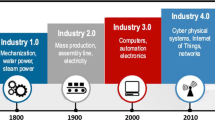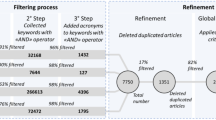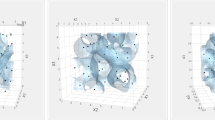Abstract
A successful and profitable product platform strategy requires both product family architecture and assembly process reasoning. New product family member production cost and time can be significantly reduced by utilizing available assembly resources, which can be achieved through systematic assembly process reasoning. A method to utilize existing assembly plant resources, during the development of new product family members, requires comparing feasible assembly processes with exiting assembly plants. The set of feasible assembly sequences for a product family member is modelled by developing an assembly sequence design space, which is combinatorial in nature, and applying constraints on the space. Models that capture effects of constraints on these spaces, explicitly represent feasible regions, and efficiently enumerate designs within this space are investigated. The feasible space is then searched to determine new product assembly sequence that will require minimum change in the current assembly plant. An automotive front structure family is utilized to demonstrate application of the assembly sequence space to perform assembly reasoning to increase exiting assembly plant resource utilization.
Similar content being viewed by others
References
Agarwal M., & Cagan J. (1998). A blend of different tastes The language of coffeemakers. Environment and Planning B: Planning and Design 25(2): 205–226
Aigner, M. (1989). Combinatorial search. New York: B. G. Teubner.
Baldwin D., Abell T., Lui M.C.M., De Fazio T., & Whitney D. (1991). An integrated computer aid for generating and evaluating assembly sequences of mechanical products. IEEE Transactions on Robotics and Automation, 7(1): 78–94
Bermner, R. (1999). Common knowledge. Financial Times – Automotive World, June 1999, pp. 42–46.
Bonneville, F., Perrard, C., & Henrioud, J. M. (1995). A genetic algorithm to generate and evaluate assembly plans. In IEEE symposium on emerging technology and factory automation (pp. 231–239).
Bower J.L., & Hout T. (1988). Fast cycle capability for competitive power. Harvard Business Review 66: 110–118
Chen, S. F. (1998). Assembly planning – A genetic approach. In 24th design automation conference, Proceedings of ASME DETC’98, Paper No.DETC98/DAC-5798. Atlanta, Georgia.
De-Fazio T.L., & Whitney D.E. (1987) Simplified generation of all mechanical assembly sequences. IEEE Journal Of Robotics And Automation RA-3(6): 640–658
Delchambre A. (1992) Computer-aided assembly planning. London UK: Chapman & Hall
De-Mello L.S.H., & Sanderson A.A. (1991) A correct and complete algorithm for the generation of mechanical assembly sequences. IEEE Transaction on Robotics and Automation, 7(2): 228–240
De Lit P., & Delchambre A. (2003) Integrated design of a product family and its assembly system. Norwell, MA: Kluwer Academic Publishers
Eastman, C. M. (1981). The design of assembly. SAE Technical Paper Series 0148-7191/81/0223-0197.
Finger, S., & Dixon, J. R. (1989). A review of research in mechanical engineering design. Part I: Descriptive, prescriptive, and computer based models of design processes. Research in Engineering Design, 1, 51–67, 121–137.
Gero, J. S., Kazakov, V., & Schnier, T. (1997). Genetic engineering and design problems. In D. Dasgupta & Z. Michalewicz (Eds.), Evolutionary algorithms in engineering applications (pp. 47–68). Berlin: Springer Verlag.
Gottipolu R.B., & Ghosh K. (1997). Representation and selection of assembly sequences in computer-aided assembly process planning. International Journal of Product Research, 35(12): 3447–3465
Heinrich, M., & Jungst, E. (1991). A resource-based paradigm for the configuring of technical systems from modular components. In Proceedings seventh IEEE conference on artificial intelligence applications (pp. 257–264).
Hollins B., & Pugh S. (1990). Successful product design. Boston, MA: Butterworths
Kobe G. (1997). Platforms – GM’s seven platform global strategy. Automotive Industries, 177: 50
Kolodner J. (1993). Case-based reasoning. San Mateo, CA: Morgan Kaufmann
Kota, S., & Ward, A.C. (1990). Functions, structures, and constraints in conceptual design. In Proceedings of the 2nd international conference on design theory and methodology, DE-Vol. 27 (pp. 239–250). Chicago, IL.
Laperriere L., & Eimaraghy H. (1996). GAPP: A generative assembly process planner. Journal of Manufacturing Systems, 15(4): 282–293
Lee, S. (1992). Backward assembly planning with assembly cost analysis. In Proceedings of 1992 IEEE international conference on robotics and automation (pp. 2382–2391). Nice, France.
McDermott C.M., & Stock G.N. (1994). The use of common parts and designs in high-tech industries: A strategic approach. Production and Inventory Management Journal, 35(3): 65–68
Mittal, S., & Falkenheiner, B. (1990). Dynamic constraint satisfaction problems. In Proceedings of AAAI-90 the eighth national conference on artificial intelligence (pp. 25–32).
Nugen F. (1999). Enumerating with constraints on the Hierarchy space. Unpublished manuscript, Georgia Institute of Technology.
Pine B.J. (1993). Mass customization – The New frontier in business competition. Boston, MA: Harvard Business School Press
Reddy G., & Cagan J. (1995). An improved shape annealing algorithm for truss topology generation. ASME Journal of Mechanical Design, 117: 315–321
Rosen D.W., & Dixon J.R. (1992). Languages for feature-based design and manufacturability evaluation. International Journal of Systems Automation: Research and Applications, 2(4): 353–373
Rosenman M.A., & Gero J.S. (1999). Evolving designs by generating useful complex gene structures. In P. J. Bently (Ed.), Evolutionary design by computers. San Francisco, CA: Morgan Kaufmann.
Sacerdoti E.D. (1974). Planning in a Hierarchy of abstraction spaces. Artificial Intelligence, 5: 115–135
Sebaaly, M. F., & Fujimoto, H. (1996). A genetic planner for assembly automation. Proceedings of the IEEE conference on evolutionary computation (pp. 401–406).
Siddique Z., & Martinez-Larrosa J.A. (2004). Development of product family CAD module using parametrics, mating relationships, and modularity. International Journal of Agile Manufacturing Systems 7(2): 79–86
Siddique Z., & Rosen D.W. (2001). On discrete design spaces for the configuration design of product families. AIEDAM Journal, 15(2): 91–108
Siddique, Z., Rosen, D., & Wang, N. (1997). Investigations of platform commonality using configuration design methods. Ford Motor Company.
Siddique, Z., & Yanjiang, Z. (2002). Automatic generation of product family member CAD models supported by a platform using a template approach. In ASME design engineering technical conferences, Paper No. DETC2002/CIE-34407. Montreal, Quebec, Canada: ASME.
Soininen T., Tiihonen J., Mannisto T., & Sulonen R. (1998). Towards a general ontology of configuration. Artificial Intelligence for Engineering Design, Analysis and Manufacturing, 12(4): 357–372
Stalk G.J., & Hout T. (1990). Competing against time. New York: Free Press
Wheelwright S.C., & Clark K.B. (1992). Revolutionizing product development: Quantum leaps in speed, efficiency and quality. New York: The Free Press
Author information
Authors and Affiliations
Corresponding author
Rights and permissions
About this article
Cite this article
Siddique, Z., Wilmes, L. An application of design space for assembly process reasoning to utilize current assembly plant resources for new product family members. J Intell Manuf 18, 171–184 (2007). https://doi.org/10.1007/s10845-007-0013-0
Received:
Accepted:
Published:
Issue Date:
DOI: https://doi.org/10.1007/s10845-007-0013-0




